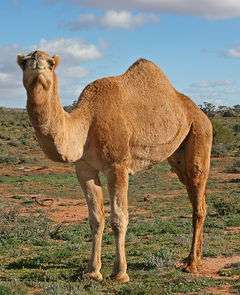Pseudoruminant
Pseudoruminant is a classification of animals based on its digestive tract differing from the ruminants. Hippopotamidae (comprising hippopotami) are ungulate mammals with a three-chambered stomach (ruminants have a four-chambered stomach).[1] Camels & hippopotami are examples of pseudoruminants.[2]
Anatomy
Like ruminants, the pseudoruminants use foregut fermentation to break down cellulose in fibrous plant species. But in contrast to these, pseudoruminants have three-chambered stomachs while ruminants have four chambers.
Species
| Pseudoruminant | Image | Class | Weight |
|---|---|---|---|
| Hippopotamus |  |
Hippopotamus | 1.5 to 3.5 tonnes |
| Camel |  |
Camel | 0.3 to 1.0 tonnes |
See also
References
- ↑ Fowler, M.E. (2010). "Medicine and Surgery of Camelids", Ames, Iowa: Wiley-Blackwell. Chapter 1 General Biology and Evolution addresses the fact that camelids (including llamas and camels) are not ruminants, pseudo-ruminants, or modified ruminants.
- ↑ Laws, Richard (1984). The Encyclopedia of Mammals. New York: MacDonald D. ed. pp. 506–511. ISBN 0-87196-871-1.
This article is issued from
Wikipedia.
The text is licensed under Creative Commons - Attribution - Sharealike.
Additional terms may apply for the media files.